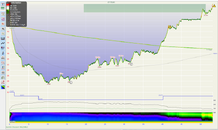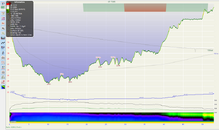The question is; which one is right vs which one do you want to be right?But the difference was not 3 minutes. It was 10+ minutes. Same algorithem, same dives, same everything. And simple dives as can be seen in the graphs.
It's not a minor difference and shouldn't be dismissed.
You are using an out of date browser. It may not display this or other websites correctly.
You should upgrade or use an alternative browser.
You should upgrade or use an alternative browser.
Discrepancy between my computers during the dive
- Thread starter pisauron
- Start date
Please register or login
Welcome to ScubaBoard, the world's largest scuba diving community. Registration is not required to read the forums, but we encourage you to join. Joining has its benefits and enables you to participate in the discussions.
Benefits of registering include
- Ability to post and comment on topics and discussions.
- A Free photo gallery to share your dive photos with the world.
- You can make this box go away
pisauron
Contributor
Seeing as 5 other buddies in the dive didn't go into deco, I'm guessing what was right with high certainty.The question is; which one is right vs which one do you want to be right?
pisauron
Contributor
Hi @pisauron
No, CNS% is time of exposure and ppO2. It doesn't matter if there was deco or not.
The discrepancy in CNS% is interesting in addition to the NDL difference. I would alert Ratio to both in your communication.
If your Ratio computer is operating at the wrong atmospheric pressure/altitude, it might explain both the shorter NDL and the higher oxygen exposure. Can you find the surface pressure for your dive on the Ratio as I am able to do for my Teric in the Shearwater Cloud?
View attachment 839339
I am able to find the surface pressure for the Ratio but not for the Garmin. The Garmin doesn't show in the logs.
The Ratio Atm. Pressure was 1018 mBar.
No one got bent either right? There are no absolutes on these, its software guess-o-rythems, the best way to avoid this issue is to get two computers from the same company and era, and if you don’t want to veer to far off from your buddies you should probably all use the same computers, sell the Ratio and buy another Garmin or whatever.Seeing as 5 other buddies in the dive didn't go into deco, I'm guessing what was right with high certainty.
pisauron
Contributor
No one got bent either right? There are no absolutes on these, its software guess-o-rythems, the best way to avoid this issue is to get two computers from the same company and era, and if you don’t want to veer to far off from your buddies you should probably all use the same computers, sell the Ratio and buy another Garmin or whatever.
Or we can just say the Ratio algorithem is broken somehow and point this to the company and maybe help others in the community.
How about we be more helpful...
- Messages
- 21,487
- Reaction score
- 21,742
- Location
- Philadelphia and Boynton Beach
- # of dives
- 2500 - 4999
So much for the pressure being an explanation for the short NDL and higher CNS%.I am able to find the surface pressure for the Ratio but not for the Garmin. The Garmin doesn't show in the logs.
The Ratio Atm. Pressure was 1018 mBar.
It will be interesting to see what Ratio says. I've exhausted my guesses.
It may be broken but unless you get a few more of their computers involved it may just be this one. It’s still just a software difference otherwise.Or we can just say the Ratio algorithem is broken somehow and point this to the company and maybe help others in the community.
How about we be more helpful...
So far to many treat algorithms as a religion in my opinion.
dmaziuk
Contributor
Not anymore as the Heinrich Weihkamp died.
This means there is a difference between the programmers about the 'offgassing'.
As a programmer I promise you there isn't. It's a (relatively) simple function of delta-pressure and time. That why we like ZH-L so much: it's simple.
Since binary CPUs operate on integers and the formula: on real numbers, there is a CPU and implementation-dependent round-off/truncation error that can accumulate over time and result in a noticeable discrepancy, but that would a) take a very long dive and b) never result in one implementation "not off-gassing".
eja12a
Registered
Please share what you find. The discrepancy is definitely concerning.
I also dive with two different branded dive computers running the same Algorithm. A Garmin on my left wrist and a Shearwater on my right. I've never seen much of a difference between the two. NDL, Depth, and Surf GF are pretty much spot on. Occasionally, I may see a slight discrepancy in Depth, NDL, or Surf GF, but I'm only talking about 1', 1', or 1%. And that could be attributed just to differences in where my arms are / have been, as well as sensor tolerances. Certainly nowhere near what you are seeing. Mine are close enough that I'm confident that they are right enough.
That’s the setup I use and I have pretty much the same experience. My Garmin G1 usually reads slightly deeper (maybe a foot or so) and generally clears my deco faster than my perdix. But we’re talking maybe a minute faster than my perdix, so they’re close enough I would feel comfortable surfacing when it clears.
pisauron
Contributor
Updating the Ratio response:
Hello Mark,
We have analyzed the logs you sent us, from Friday to Monday, with particular attention to the dives made on Sunday.
It is important to remember that we are talking about the "theory" of decompression. Although there are commonly accepted guidelines, there is no "exactly correct" answer regarding the profile to follow. For a single dive, two computers using the same model with the same settings will give similar results, but the calculations and factors to consider increase exponentially in the case of repetitive diving, or multiple repetitive dives (being indeed an algorithmic calculation).
Even minimal differences in the implementation of the model to obtain an "algorithm" (consider that the original Bühlmann model is written in prose and that Baker's gradient implementations also have margins of interpretation), along with necessary rounding, can lead to having "different" results in cases like this. (Although at the end of the dive both computers did not report "mandatory" deco stops having recalculated the non-necessity to perform deco stops.)
In addition to the above, in this specific case, we can see that the two computers start the repetitive dives with different CNS values. The CNS value does not influence the decompression calculation (at least it does not on the RATIO, but I believe Garmin does not consider it either), but it might indicate that the two computers off-gas the tissues slightly differently.
To have a third term of comparison, we set up Subsurface with BUL settings and gradients 70/85. The result from Subsurface would have been even more conservative compared to both dive computers. (in the images, the deco suggested by Subsurface is shown in green, the one by RATIO in red).
So, in summary, even if two implementations follow the definition of a decompression model to the letter, they might process "different" decompression plans. In practice, these differences should be small (like a small percentage of the total decompression time) and therefore be obscured by rounding and the systematic error margin that the implemented algorithms necessarily adopt. These differences become more visible with multiple repetitive dives that "stress" the algorithm more. (after all, we do not have precise information on everything that is happening in the body of a diver).
At your disposal
Best Regards
Mario
Ratio® Computers - Support
Hello Mark,
We have analyzed the logs you sent us, from Friday to Monday, with particular attention to the dives made on Sunday.
It is important to remember that we are talking about the "theory" of decompression. Although there are commonly accepted guidelines, there is no "exactly correct" answer regarding the profile to follow. For a single dive, two computers using the same model with the same settings will give similar results, but the calculations and factors to consider increase exponentially in the case of repetitive diving, or multiple repetitive dives (being indeed an algorithmic calculation).
Even minimal differences in the implementation of the model to obtain an "algorithm" (consider that the original Bühlmann model is written in prose and that Baker's gradient implementations also have margins of interpretation), along with necessary rounding, can lead to having "different" results in cases like this. (Although at the end of the dive both computers did not report "mandatory" deco stops having recalculated the non-necessity to perform deco stops.)
In addition to the above, in this specific case, we can see that the two computers start the repetitive dives with different CNS values. The CNS value does not influence the decompression calculation (at least it does not on the RATIO, but I believe Garmin does not consider it either), but it might indicate that the two computers off-gas the tissues slightly differently.
To have a third term of comparison, we set up Subsurface with BUL settings and gradients 70/85. The result from Subsurface would have been even more conservative compared to both dive computers. (in the images, the deco suggested by Subsurface is shown in green, the one by RATIO in red).
So, in summary, even if two implementations follow the definition of a decompression model to the letter, they might process "different" decompression plans. In practice, these differences should be small (like a small percentage of the total decompression time) and therefore be obscured by rounding and the systematic error margin that the implemented algorithms necessarily adopt. These differences become more visible with multiple repetitive dives that "stress" the algorithm more. (after all, we do not have precise information on everything that is happening in the body of a diver).
At your disposal
Best Regards
Mario
Ratio® Computers - Support
Attachments
Similar threads
- Replies
- 99
- Views
- 12,825
- Replies
- 24
- Views
- 1,651
- Replies
- 3
- Views
- 1,025
- Replies
- 120
- Views
- 3,944
- Replies
- 13
- Views
- 1,459





